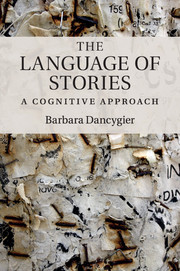Book contents
- Frontmatter
- Contents
- Figures
- Acknowledgements
- Introduction
- 1 Language and literary narratives
- 2 Blending, narrative spaces, and the emergent story
- 3 Stories and their tellers
- 4 Viewpoint
- 5 Referential expressions and narrative spaces
- 6 Fictional minds and embodiment in drama and fiction
- 7 Speech and thought in the narrative
- 8 Stories in the mind
- Notes to the text
- References
- Literary works cited
- Index
7 - Speech and thought in the narrative
Published online by Cambridge University Press: 05 November 2011
- Frontmatter
- Contents
- Figures
- Acknowledgements
- Introduction
- 1 Language and literary narratives
- 2 Blending, narrative spaces, and the emergent story
- 3 Stories and their tellers
- 4 Viewpoint
- 5 Referential expressions and narrative spaces
- 6 Fictional minds and embodiment in drama and fiction
- 7 Speech and thought in the narrative
- 8 Stories in the mind
- Notes to the text
- References
- Literary works cited
- Index
Summary
Can Rita and I blow up the post office?
(American Pastoral, Philip Roth)In this chapter I will consider a range of literary language forms in which the formal distinction between speech and thought is used in different constructions specific to narrative discourse. Narrative discourse is typically treated as a discourse genre independent of colloquial usage, although, as I argued in , there are conceptual similarities, even if accompanied by formal differences. Further distinctions within the broad category typically address the difference between generic narrative purposes (pure narration) and the representation of discourse attributed to specific characters (Speech and Thought Representation, or STR); the latter are in turn talked about as direct discourse (as in He said, ‘I like it’), indirect discourse (He said that he liked it) and free indirect discourse (He liked it). The literature on these constructions is extremely rich, with much of the work recently brought together in Vandelanotte (), but since the issue is beyond the scope of my present concerns, I will only discuss selected instances of uses pertinent to the issue of viewpoint and story-construction.
Above, I only used the term ‘discourse,’ without distinguishing speech from thought. In fact, I will be arguing below that not only is the distinction not salient enough, it is also misleading. As I have shown in , linguistic forms specific to speech have been co-opted into the representation of thoughts and feelings quite early on. In fact, these forms themselves suggest that the nature of all literary forms is such that, being based in the language resources, they need to rely at least partially on available constructions to express meanings which are not the core of the constructions’ semantics. In drama, indeed, speech, and more specifically speech profiling a potential addressee, is a common choice in representation of thought and feeling. Languages rarely (if at all) use constructions which formally distinguish speech from thought, since what matters most is the attribution of content to a specific character and thought is often communicated through speech.
- Type
- Chapter
- Information
- The Language of StoriesA Cognitive Approach, pp. 171 - 194Publisher: Cambridge University PressPrint publication year: 2011

